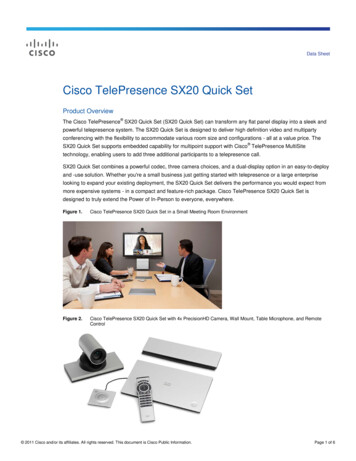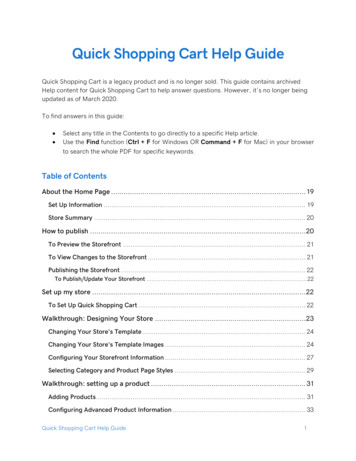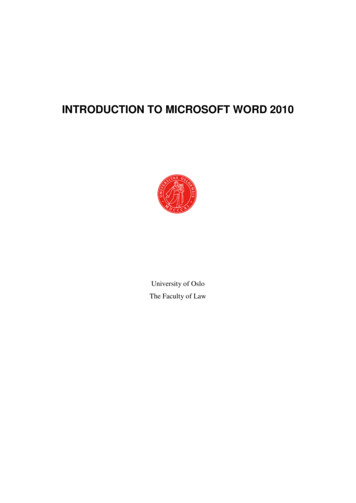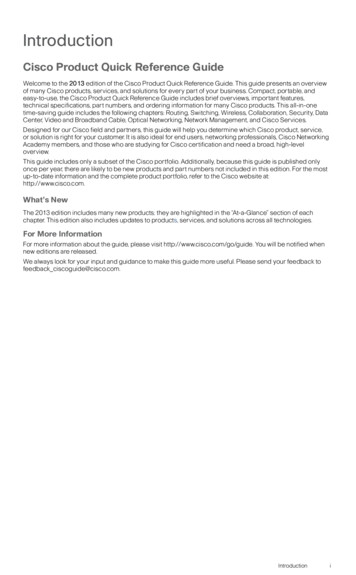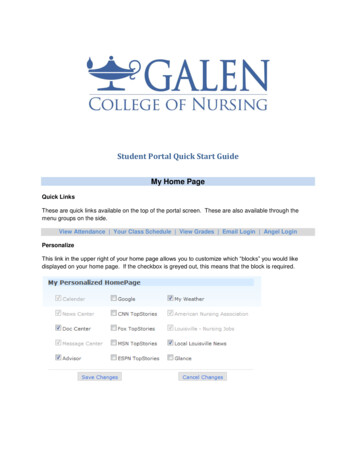
Transcription
A Quick Introduction to Non-EuclideanGeometryA Tiling of the Poincare PlaneFrom Geometry: Plane and Fancy, DavidSinger, page 61.Dr. Robert GardnerPresented at Science Hill High SchoolMarch 22, 20061
Euclidean GeometryEuclid (325 bce – 265 bce)Note. (From An Introduction to the History of Mathematics, 5thEdition, Howard Eves, 1983.) Alexander the Great founded the city ofAlexandria in the Nile River delta in 332 bce. When Alexander diedin 323 bce, one of his military leaders, Ptolemy, took over the region ofEgypt. Ptolemy made Alexandria the capitol of his territory and startedthe University of Alexandria in about 300 bce. The university had lecturerooms, laboratories, museums, and a library with over 600,000 papyrusscrolls. Euclid, who may have come from Athens, was made head of thedepartment of mathematics. Little else is known about Euclid.2
The eastern Mediterranean from“The World of the Decameron” website.Note. Euclid’s Elements consists of 13 books which include 465 propositions. American high-school geometry texts contain much of the materialfrom Books I, III, IV, VI, XI, and XII. No copies of the Elements survivefrom Euclid’s time. Modern editions are based on a version prepared byTheon of Alexandria, who lived about 700 years after Euclid. No work,except for the Bible, has been more widely used, edited, or studied, andprobably no work has exercised a greater influence on scientific thinking.3
Note. The definitions given in Euclid’s Elements are not at all modern.Some examples are: A point is that which has no part. A line is breadthless length. A straight line is a line which lies evenly with the points on itself. Parallel straight lines are straight lines which, being in the same planeand being produced indefinitely in both directions, do not meet oneanother in either direction.Note. The postulates of Euclidean geometry are (as stated in The Elements and a restatement in more familiar language):1. To draw a straight line from any point to any point. There is oneand only one straight line through any two distinct points.2. To produce a finite straight line continuously in a straight line. Aline segment can be extended beyond each endpoint.3. To describe a circle with any center and distance. For any pointand any positive number, there exists a circle with the point as centerand the positive number as radius.4. That all right angles are equal to one another.5. That, if a straight line falling on two straight lines make the interior angles on the same side less than two right angles, the twostraight lines, if produced indefinitely, meet on that side on whichare the angles less than the two right angles.4
Note. Euclid started with ideas of points and lines as we draw them onflat pieces of paper, and then tried to set up definitions that are consistentwith the behavior of the paper models. This is not at all the modernway that mathematicians view things (at least philosophically). Manymathematicians start with definitions and axioms which have no meaningat all beyond the meaning given by the axioms and definitions (this iscalled the formalist approach to math).David Hilbert (1862-1943)A famous quote by 20th century geometer David Hilbert is: “One mustbe able to say at all times – instead of points, straight lines, and planes –tables, chairs, and beer mugs.” Hilbert’s point here is that we should notput any meaning into the words used in mathematics beyond the meaninggiven by the definitions of mathematics. Put in contemporary terms, thedrawings of points and lines on paper are not points and lines, but form amodel for Euclidean geometry.5
Note. Euclid seems to avoid the use of the parallel postulate and proves28 propositions without using the parallel postulate. Two such resultsinclude:Proposition 27. If a straight line falling on two straight lines makes thealternate angles equal to one another, then the straight lines are parallelto one another.Proposition 28. If a straight line falling on two straight lines makesthe exterior angle equal to the interior and opposite angle on the sameside, or the sum of the interior angles on the same side equal to two rightangles, then the straight lines are parallel to one another.6
Note. The first result in the Elements which uses the parallel postulatein its proof is:Proposition 29. A straight line falling on parallel straight lines makesthe alternate angles equal to one another, the exterior angle equal to theinterior and opposite angle, and the sum of the interior angles on the sameside equal to two right angles.7
Note. Some results from Euclidean geometry which are equivalent to theparallel postulate are:1. Two lines that are parallel to the same line are parallel to each other.2. A line that meets one of two parallels also meets the other.3. There exists a triangle whose angle-sum is two right angles.4. Parallel lines are equidistant from one another.5. Similar triangles exist which are not congruent.6. Any two parallel lines have a common perpendicular.7. Playfair’s Theorem. For a given line g and a point P not on g,there exists a unique line through P parallel to g.8
Note. None of the above results are surprising to those of us familiar withEuclidean geometry. The only thing that is maybe surprising is that wewould go to such lengths to prove these obvious results! However, theseresults are only “obvious” in Euclidean geometry and they are familiar tous because of our model (points and lines on paper) of Euclidean geometry.However, there are models of geometry where each of the above resultsis not only not obvious, but not even true! We have only considered onemodel for geometry. But. . .9
Non-Euclidean GeometryNote. Playfair’s Theorem is equivalent to the Parallel Postulate:Playfair’s Theorem. For a given line g and a point P not on g, there exists aunique line through P parallel to g.If we negate it, we get a version of non-Euclidean geometry. There are two options:Parallel Postulate for Spherical Geometry. For a given line g and a pointP not on g, there are no lines through P parallel to g.Parallel Postulate for Hyperbolic Geometry. For a given line g and a pointP not on g, there is more than one line through P parallel to g.We now consider models for each of these geometries. We can then use these modelsto illustrate some properties of non-Euclidean geometry.10
Note. We model spherical geometry by using the surface of a sphere torepresent a plane and using great circles of the sphere to represent lines(and points on the sphere to represent points).From David Royster’s webpage on spherical geometry.Note. Some properties of spherical geometry include: There are no parallel lines.11
The sums of the angles of a triangle are always greater than 180 . Smalltriangles have angle sums slightly greater than 180 and large triangleshave angle sums much more than 180 (but always less than 900 ).A spherical triangle, from Answers.com. Triangles are only similar (i.e., the same shape) when they are congruent(i.e., the same size).12
Note. This model of non-Euclidean geometry is easy to visualize and one wonderswhy it took so long to recognize this as a valid model geometry (in fact, this was notrecognized until the 1850s with the work of Georg Bernhard Riemann). Historically,there are two problems. The first is that Euclid assumes (both explicitly andimplicitly) that lines are infinite in extent and so since “lines” on the sphere arealways finite in length (namely, 2πr), then this spherical geometry does not count asa viable option. The second problem is philosophical — it was simply not believedthat there were geometries other than the one described by Euclid. In fact, many ofthe properties of spherical geometry were studied in the second and first centuriesbce by Theodosius in Sphaerica. However, Theodosius’ study was entirely basedon the sphere as an object embedded in Euclidean space, and never considered itin the non-Euclidean sense.Note. Now here is a much less tangible model of a non-Euclidean geometry.Although hyperbolic geometry is about 200 years old (the work of Karl FrederichGauss, Johann Bolyai, and Nicolai Lobachevsky), this model is only about 100years old!Johann BolyaiKarl GaussNicolai Lobachevsky1802–18601777–18551793–185613
Definition. The Poincare disk model of hyperbolic geometry representsthe “plane” as an open unit disk, “points” of the plane are points of thedisk, and “lines” are circular arcs which are perpendicular to the boundaryof the disk.14
Note. Some properties of hyperbolic geometry are:Through a point not on a given line, there is more than one line (in fact,an infinite number) through the point parallel to the given line.The sums of the angles of a triangle is always less than 180 . Smalltriangles have angle sums slightly less than 180 and large triangleshave angle sums much less than 180 (in fact, as close to 0 as welike).Triangles are only similar (i.e., the same shape) when they are congruent(i.e., the same size).15
Note. One apparent shortcoming of the Poincare model is that “lines”are not infinite in length. This is not the case since, in this model, distancesare not measured in the usual (i.e., Euclidean) way. If you are familiarwith calculus, then we can say the differential of arclength, ds, satisfiesdx2 dy 22ds . Now if we consider the diameter D of the disk(1 (x2 y 2))2from ( 1, 0) to (1, 0), we have the lengthZ 1Z11 x1dxds ln .221 x 1D 1 1 xIn general, “lines” in the Poincare disk are infinite (under this measure ofarclength).Conclusion. So we have three possible models for geometry. Some oftheir properties are:EuclideanSphericalHyperbolicAngle SumsSimilarNumber of Parallelof TrianglesTriangles?Lines Through P180 CurvatureYES10 only when congruent0 only when congruent 180 18016
Note. Euclid’s Elements consists of 13 books which include 465 proposi-tions. American high-school geometry texts contain much of the material from Books I, III, IV, VI, XI, and XII. No copies of the Elements survive from Euclid’s time. Modern editions are based on a version prepared by

